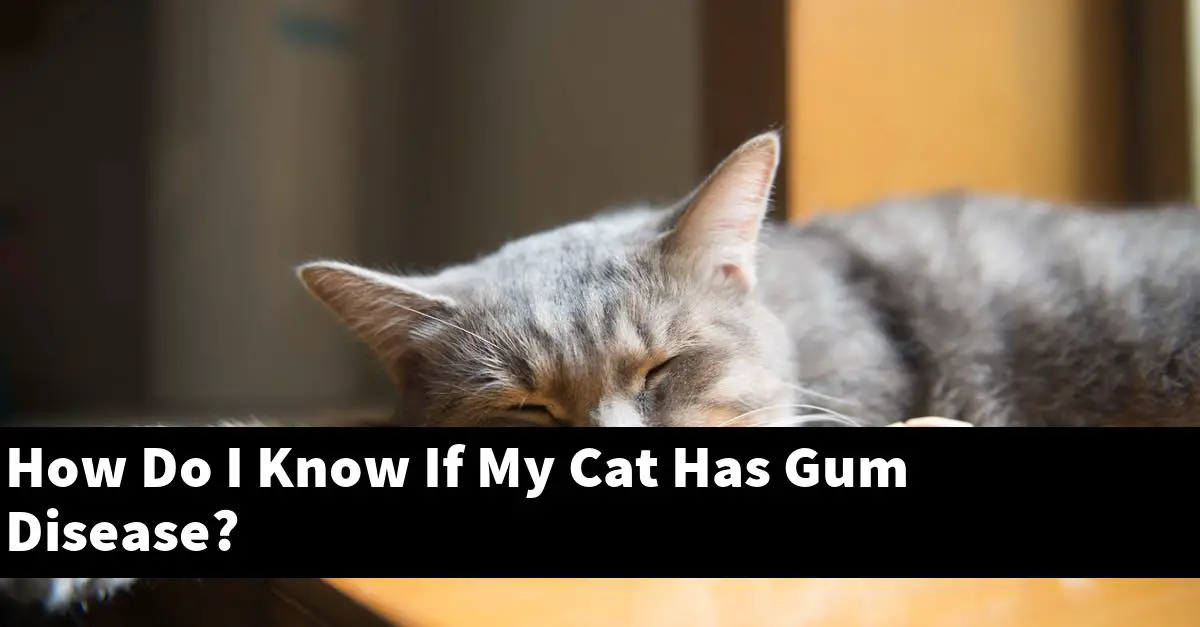Gum disease is a serious condition that can affect both humans and animals. In cats, gum disease is often caused by plaque and tartar buildup on the teeth.
This can lead to gingivitis, an inflammation of the gums. If left untreated, gum disease can progress to periodontitis, a more serious condition that can damage the bones and tissues around the teeth.
Symptoms of gum disease in cats include bad breath, bleeding gums, and difficulty eating. If you suspect that your cat may have gum disease, it is important to take them to the vet for an examination and treatment.
How do you reverse gum disease in cats?
One of the most common dental problems in cats is gum disease. Gum disease is caused by plaque, a build-up of bacteria on the teeth and gums.
The bacteria forms a sticky film that can cause the teeth to loosen and the gums to recede.
There are several ways to treat gum disease in cats. One method is to use a toothbrush and toothpaste to remove the plaque and bacteria from the teeth and gums.
Another method is to use a mouth rinse to clean the teeth and gums. A final method is to use a dental pill to remove the plaque and bacteria.
If the gum disease is severe, a veterinarian may also prescribe antibiotics to kill the bacteria. In most cases, gum disease can be treated with a combination of methods.
Has my cat got gum disease?
Gum disease is a common dental disease in cats. It is caused by bacteria that attack the tooth roots and gum tissues.
The bacteria produce toxins that damage the teeth and gums. Gum disease can lead to tooth loss and other health problems.
To test for gum disease, your veterinarian will take a mouthful of your cat’s saliva and check for the presence of bacteria. If your cat has gum disease, your veterinarian will prescribe an appropriate treatment.
What can I give my cat for gum infection?
There are a few options for treating a cat with gum infection. If the infection is mild, a veterinarian may prescribe an antibiotic ointment or a mouth rinse.
If the infection is more severe, the veterinarian may prescribe a systemic antibiotic. If the infection is severe, the cat may need to be hospitalized.
How do you know if your cat’s gums hurt?
The signs of gum pain in cats can vary, but typically the cat will exhibit one or more of the following:
Struggling to chew or bite
Reduced appetite
Swollen or tender gums
Rapid breathing
Fever
If you notice any of these signs, it is important to take your cat to the veterinarian for an examination. The veterinarian can determine the cause of the pain and prescribe a treatment.
How can I tell if my cat has a tooth infection?
There are a few ways to tell if your cat has a tooth infection. One way is to examine the teeth closely for signs of inflammation, redness, and swelling.
Another way is to take a sample of the tooth’s plaque and/or tartar and send it to a laboratory for analysis. If the infection is severe, your cat may have trouble eating, drinking, or breathing.
In some cases, tooth abscesses may develop, and your cat may exhibit signs of fever, lethargy, and abdominal pain.
What does gingivitis look like in cats?
Gingivitis is a condition in which the gums become inflamed and red. The inflammation can spread to the rest of the mouth, and the cat may have difficulty eating or drinking.
Gingivitis can be caused by a variety of factors, including viral infections, untreated dental disease, and environmental factors (such as exposure to chemicals or toxins). Treatment typically involves antibiotics to clear the infection and pain relief.
Does wet cat food cause gingivitis?
It is largely anecdotal. Some people anecdotally believe that wet cat food can cause gingivitis, while others have no experience with this and cannot provide a scientific answer.
There is no definitive scientific evidence to support or refute the claim that wet cat food can cause gingivitis.
What should my cat’s gums look like?
When a cat eats, their teeth and jaws move up and down, grinding the food between the teeth and the gums. This action flushes the teeth and gums with saliva, which helps to break down food and remove any harmful substances.
The gums should be pink, red, or slightly swollen, and should be free of any yellow or black patches. If there is any bleeding, it should stop quickly.
If the gums become very loose or detached, or if the cat starts to lose teeth, it is a sign that they have a dental problem and should be seen by a veterinarian.
How much does it cost to treat gingivitis in cats?
Gingivitis is an inflammation of the gums. It is a common problem in cats and can be caused by a variety of factors, including oral hygiene problems, infectious diseases, and even certain foods.
Treatment typically involves using an antiseptic mouthwash and/or an oral antibiotic. In some cases, surgery may also be required to remove the inflammation.
Can gingivitis cause death in cats?
It is still unknown whether gingivitis can lead to death in cats. However, there are a few studies that suggest that gingivitis may be a risk factor for death in cats.
One study found that cats with gingivitis were more likely to die from other causes, such as accidents or infections. Another study found that cats with gingivitis had a higher death rate from oral cancer.
However, it is still unclear whether gingivitis is the sole cause of these deaths or if other factors are also involved.
Conclusion
If your cat is showing any of the following signs, they may have gum disease: bad breath, red and swollen gums, bleeding gums, or difficulty eating. If you suspect your cat has gum disease, take them to the vet for an evaluation.


